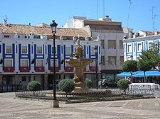
Valdepeñas
Encyclopedia
Valdepeñas is a municipality in the province of Ciudad Real, in the autonomous community of Castile-La Mancha
, Spain
. It is also the seat of the judicial district that covers the localities of Moral de Calatrava
, Santa Cruz de Mudela
, Viso del Marqués
, Torrenueva
, Castellar de Santiago
and Almuradiel
.
Valdepeñas is located in the Campo de Calatrava, an extensive plain north of the Sierra Morena
, and lies on the left bank of Jabalón River, a tributary of the Guadiana
.
The hamlet
(pedanía) of Consolación
depends from Valdepeñas and is located at the intersection between Autovía A-4
(Autovia del Sur) and road CR-5214. It was built by the Instituto Nacional de Colonización
in 1949.
called Culture of the Motillas
, dated between the 10th and 13th centuries BC. Vasco Merlo in their History of Valdepeñas described these structures erroneously as Celtiberian
settlements, despite them being much older than that and possibly belonging to the Culture of Argar.
city of “Cerro de las Cabezas” (Hill of the Heads), a great oppidum
or town fortified with a true castle in the summit of the hill that it occupies, inhabited between the 7th and 2nd centuries BC. It is an important archaeological deposit of the Oretana Culture and shows signs of the first vestige of the grapevine
in this region.
In the 16th century and later artefacts such as graves, coins and other ancient Roman items, from a Roman villa of the 1st century BC, that still existed in the Visigothic period.
. The Arab inscriptions and a sun dial on the walls of the Church of the Assumption date from this period. According to oral tradition, the Caliphate gave permission to the inhabitants to cultivate vineyards and make wine. This is prohibited by the Quran.
The Moors were expelled from Valdepenas at the end of the 15th century.
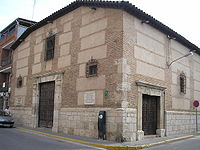 By order of Queen Berenguela of Castile
By order of Queen Berenguela of Castile
and after the battle of Las Navas de Tolosa
in 1212, settlers of several villages (Aberturas, Corral Rubio de Jabalón, Santa María de las Flores and Castilnuevo) moved to the area around the present Church of the Assumption, which had been an old castle.
From that moment Valdepeñas belonged to the military Order of Calatrava
and the first text it is mentioned in is the record of The Order of Calatrava in 1243. The new settlers coming from the Kingdoms of Castile
, León
(Galicia mainly) and Aragón
. The Order demanded conditions of establishment and right of citizenship, the continued care of the grapevine.
In medieval times the Jewish
community became important and this is reflected in the existence at least two synagogue
s, one of which was eventually converted into the hermitage of Veracruz and the old building where the Parish of The Christ was located, behind its present location.
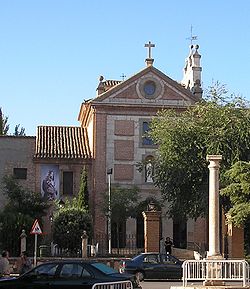 The Catholic Monarchs
The Catholic Monarchs
, Ferdinand and Isabella of Castille, lodged in Valdepeñas on 18 February 1488 at the mother of Alfonso de Merlo's house, and left to the care of the widow the infants during part of the conquest of Granada.
The same Alfonso de Merlo was named Captain and went with more than two hundred men to the Conquest of Granada, funding the campaign with their own money. The Catholic Monarchs recognized him and granted him the title of Knight. Some of their descendants moved to the New World, took important positions in Peru and Chile.
Currently diverse religious and civil buildings from the 16th century such as the Trinitarians Covent can be found in the town.
King Ferdinand the Catholic wanted to control the power of Military Orders and Pope Adrian VI
granted orders to the Kingdom of Castile, passing to Royal Jurisdiction an important patrimony: two cities, two hundred villas (Valdepeñas among them) and a hundred of villages, distributed in an ample territory.
sold the villa on 22 April 1575 to D. Alvaro de Bazán first Marquess of Santa Cruz, who became Lord of Valdepeñas. Valdepeñas would happen to be a “Señorío”, secreting itself of the Order of Calatrava.
The successive marquesses promoted the wines of Valdepeñas in the Spanish Court of the Austrian and its fame consequently extended all over the country. Valdepeñas' “clarete” became known as “aloque” at this time.
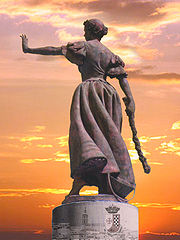 Nothing remarkable happened until 6 June 1808, when the Napoleonic occupation of Spain became an issue after the events of 2 May in Madrid of that year.
Nothing remarkable happened until 6 June 1808, when the Napoleonic occupation of Spain became an issue after the events of 2 May in Madrid of that year.
Napoleonic troops went to Andalusia as reinforcements and attempted to cross the villa; the entire population (men, women and also some of the neighbouring villas) took up arms to prevent the passage of Napoleon's troops through the villa. The result was a high number of lives lost and a major fire. Highlighted in the fight a woman: Juana Galán
"La Galana". The troops had to retreat from the province of La Mancha
, this delay, without doubt, made easier the victory in the Battle of Bailen
by the Spanish troops. The king Fernando VII would give the villa the Title of "Very Heroic". After these events some inhabitants from Valdepeñas took part of the guerrilla fighting against the Napoleonic troops in the “Guerra de la Independencia”, Francisco Abad called “Chaleco” became a famous guerrillero.
At the beginnings of the 20th century, the appearance of Phylloxera
led to the introduction of the resistant American vineyard but not changed the economy a lot. The Spanish Civil War broke this development, and the city's population decreased. During the 1940s, 1950s, 1960s and 1970s the only economical activities were agriculture and the traditional family industry of wine, a common phenomenon of central Spain in these times. In the 1980s Valdepeñas saw a modernization of the wine sector including new kinds of grapes, and the introduction of techniques in wine production.
There are two Fairs, in August "the summer fair" at the first week and in September known as "Fiesta de la Vendimia" (Grape Harvest Fair).
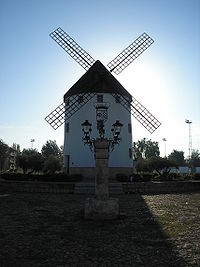 The town is home contains large distilleries, tanneries, flour mills, cooperages, and other factories, but its chief trade is in red wines. The city is famous for its wine
The town is home contains large distilleries, tanneries, flour mills, cooperages, and other factories, but its chief trade is in red wines. The city is famous for its wine
s and is the centre of a grape-growing district. Valdepeñas wines are among the most popular in Spain and recently in EU
countries. There are hot mineral springs
near the city.
Recently, in addition to the food and wine industry, there’re setting up small and medium industries located in several industrial parks.
Industries include:
Castile-La Mancha
Castile-La Mancha is an autonomous community of Spain. Castile-La Mancha is bordered by Castile and León, Madrid, Aragon, Valencia, Murcia, Andalusia, and Extremadura. It is one of the most sparsely populated of Spain's autonomous communities...
, Spain
Spain
Spain , officially the Kingdom of Spain languages]] under the European Charter for Regional or Minority Languages. In each of these, Spain's official name is as follows:;;;;;;), is a country and member state of the European Union located in southwestern Europe on the Iberian Peninsula...
. It is also the seat of the judicial district that covers the localities of Moral de Calatrava
Moral de Calatrava
Moral de Calatrava is a municipality in Ciudad Real, Castile-La Mancha, Spain. It is a municipality within the Order of Calatrava in 1212....
, Santa Cruz de Mudela
Santa Cruz de Mudela
Santa Cruz de Mudela is a municipality of the Spanish province Ciudad Real located in the southeastern corner of the autonomous community Castile-La Mancha.-Geography:...
, Viso del Marqués
Viso del Marqués
Viso del Marqués is a municipality in Ciudad Real, Castile-La Mancha, Spain. It has a population of 3,002....
, Torrenueva
Torrenueva
Torrenueva is a municipality in Ciudad Real, Castile-La Mancha, Spain. It has a population of 3,208....
, Castellar de Santiago
Castellar de Santiago
Castellar de Santiago is a municipality in the province of Ciudad Real, Castile-La Mancha, Spain. It has a population of 2,213....
and Almuradiel
Almuradiel
Almuradiel is a municipality in Ciudad Real, Castile-La Mancha, Spain. It has a population of 965....
.
Geography
Its name means "Valley of Rocks", because it is located in a wide area meander of hill the Jabalón River surrounded, just bordering on the plain south of La Mancha and the subsoil is rich in limestone rock.Valdepeñas is located in the Campo de Calatrava, an extensive plain north of the Sierra Morena
Sierra Morena
The Sierra Morena is one of the main systems of mountain ranges in Spain.It stretches for 400 kilometres East-West across southern Spain, forming the southern border of the Meseta Central plateau of the Iberian Peninsula, and providing the watershed between the valleys of the Guadiana to the...
, and lies on the left bank of Jabalón River, a tributary of the Guadiana
Guadiana
The Guadiana , or Odiana, is an international river located on the Portuguese–Spanish border, separating Extremadura and Andalucia from Alentejo and Algarve...
.
The hamlet
Hamlet (place)
A hamlet is usually a rural settlement which is too small to be considered a village, though sometimes the word is used for a different sort of community. Historically, when a hamlet became large enough to justify building a church, it was then classified as a village...
(pedanía) of Consolación
Consolación
Consolación is a hamlet in the municipal term of Valdepeñas. It is located 11 km north of the town, at the intersection between Autovía A-4 and road CR-5214....
depends from Valdepeñas and is located at the intersection between Autovía A-4
Autovía A-4
The Autovía A-4 or Autopista AP-4 is a Spanish autovía and autopista route which starts in Madrid and ends in Cádiz....
(Autovia del Sur) and road CR-5214. It was built by the Instituto Nacional de Colonización
Instituto Nacional de Colonización
The Instituto Nacional de Colonización y Desarrollo Rural, , was the administrative entity that was established by the Spanish Dictatorship in October 1939, shortly after the end of the Spanish Civil War, in order to repopulate certain areas of Spain...
in 1949.
Prehistory
The municipal area houses numerous prehistoric remains, platforms and watchtowers located in the hills, compatible with settlers of the Bronze ageBronze Age
The Bronze Age is a period characterized by the use of copper and its alloy bronze as the chief hard materials in the manufacture of some implements and weapons. Chronologically, it stands between the Stone Age and Iron Age...
called Culture of the Motillas
Motillas
The motillas were the first attested settlement of La Mancha , which took place in the Middle Bronze Age by people belonging to the culture of Bronze of Levante....
, dated between the 10th and 13th centuries BC. Vasco Merlo in their History of Valdepeñas described these structures erroneously as Celtiberian
Celtiberians
The Celtiberians were Celtic-speaking people of the Iberian Peninsula in the final centuries BC. The group used the Celtic Celtiberian language.Archaeologically, the Celtiberians participated in the Hallstatt culture in what is now north-central Spain...
settlements, despite them being much older than that and possibly belonging to the Culture of Argar.
Ancient history
Eight kilometres to the south of the city, we find The IberianIberians
The Iberians were a set of peoples that Greek and Roman sources identified with that name in the eastern and southern coasts of the Iberian peninsula at least from the 6th century BC...
city of “Cerro de las Cabezas” (Hill of the Heads), a great oppidum
Oppidum
Oppidum is a Latin word meaning the main settlement in any administrative area of ancient Rome. The word is derived from the earlier Latin ob-pedum, "enclosed space," possibly from the Proto-Indo-European *pedóm-, "occupied space" or "footprint."Julius Caesar described the larger Celtic Iron Age...
or town fortified with a true castle in the summit of the hill that it occupies, inhabited between the 7th and 2nd centuries BC. It is an important archaeological deposit of the Oretana Culture and shows signs of the first vestige of the grapevine
Grapevine
Grapevine is the common name for plants of the genus Vitis. Other meanings include:*Grapevine , a term often used to describe a form of communication by means of gossip or rumor, as in "heard it through the grapevine"...
in this region.
In the 16th century and later artefacts such as graves, coins and other ancient Roman items, from a Roman villa of the 1st century BC, that still existed in the Visigothic period.
Middle Ages
During this period the area was part of the Moorish taifa of ToledoTaifa of Toledo
The taifa of Toledo was a Muslim medieval kingdom located in what is now central Spain. It existed from the fracturing of the long-eminent Muslim Caliphate of Córdoba in 1035 until the Christian conquest in 1085.-History:...
. The Arab inscriptions and a sun dial on the walls of the Church of the Assumption date from this period. According to oral tradition, the Caliphate gave permission to the inhabitants to cultivate vineyards and make wine. This is prohibited by the Quran.
The Moors were expelled from Valdepenas at the end of the 15th century.

Berenguela of Castile
Berengaria was Queen regnant of Castile in 1217 and Queen consort of León from 1197 to 1204.-Family origins:...
and after the battle of Las Navas de Tolosa
Battle of Las Navas de Tolosa
The Battle of Las Navas de Tolosa, known in Arab history as the Battle of Al-Uqab , took place on 16 July 1212 and was an important turning point in the Reconquista and in the medieval history of Spain...
in 1212, settlers of several villages (Aberturas, Corral Rubio de Jabalón, Santa María de las Flores and Castilnuevo) moved to the area around the present Church of the Assumption, which had been an old castle.
From that moment Valdepeñas belonged to the military Order of Calatrava
Order of Calatrava
The Order of Calatrava was the first military order founded in Castile, but the second to receive papal approval. The papal bull confirming the Order of Calatrava as a Militia was given by Pope Alexander III on September 26, 1164.-Origins and Foundation:...
and the first text it is mentioned in is the record of The Order of Calatrava in 1243. The new settlers coming from the Kingdoms of Castile
Kingdom of Castile
Kingdom of Castile was one of the medieval kingdoms of the Iberian Peninsula. It emerged as a political autonomous entity in the 9th century. It was called County of Castile and was held in vassalage from the Kingdom of León. Its name comes from the host of castles constructed in the region...
, León
Kingdom of León
The Kingdom of León was an independent kingdom situated in the northwest region of the Iberian Peninsula. It was founded in AD 910 when the Christian princes of Asturias along the northern coast of the peninsula shifted their capital from Oviedo to the city of León...
(Galicia mainly) and Aragón
Aragon
Aragon is a modern autonomous community in Spain, coextensive with the medieval Kingdom of Aragon. Located in northeastern Spain, the Aragonese autonomous community comprises three provinces : Huesca, Zaragoza, and Teruel. Its capital is Zaragoza...
. The Order demanded conditions of establishment and right of citizenship, the continued care of the grapevine.
In medieval times the Jewish
Jews
The Jews , also known as the Jewish people, are a nation and ethnoreligious group originating in the Israelites or Hebrews of the Ancient Near East. The Jewish ethnicity, nationality, and religion are strongly interrelated, as Judaism is the traditional faith of the Jewish nation...
community became important and this is reflected in the existence at least two synagogue
Synagogue
A synagogue is a Jewish house of prayer. This use of the Greek term synagogue originates in the Septuagint where it sometimes translates the Hebrew word for assembly, kahal...
s, one of which was eventually converted into the hermitage of Veracruz and the old building where the Parish of The Christ was located, behind its present location.
Modern history

Catholic Monarchs
The Catholic Monarchs is the collective title used in history for Queen Isabella I of Castile and King Ferdinand II of Aragon. They were both from the House of Trastámara and were second cousins, being both descended from John I of Castile; they were given a papal dispensation to deal with...
, Ferdinand and Isabella of Castille, lodged in Valdepeñas on 18 February 1488 at the mother of Alfonso de Merlo's house, and left to the care of the widow the infants during part of the conquest of Granada.
The same Alfonso de Merlo was named Captain and went with more than two hundred men to the Conquest of Granada, funding the campaign with their own money. The Catholic Monarchs recognized him and granted him the title of Knight. Some of their descendants moved to the New World, took important positions in Peru and Chile.
Currently diverse religious and civil buildings from the 16th century such as the Trinitarians Covent can be found in the town.
King Ferdinand the Catholic wanted to control the power of Military Orders and Pope Adrian VI
Pope Adrian VI
Pope Adrian VI , born Adriaan Florenszoon Boeyens, served as Pope from 9 January 1522 until his death some 18 months later...
granted orders to the Kingdom of Castile, passing to Royal Jurisdiction an important patrimony: two cities, two hundred villas (Valdepeñas among them) and a hundred of villages, distributed in an ample territory.
Señorío of Valdepeñas
King Philip IIPhilip II of Spain
Philip II was King of Spain, Portugal, Naples, Sicily, and, while married to Mary I, King of England and Ireland. He was lord of the Seventeen Provinces from 1556 until 1581, holding various titles for the individual territories such as duke or count....
sold the villa on 22 April 1575 to D. Alvaro de Bazán first Marquess of Santa Cruz, who became Lord of Valdepeñas. Valdepeñas would happen to be a “Señorío”, secreting itself of the Order of Calatrava.
The successive marquesses promoted the wines of Valdepeñas in the Spanish Court of the Austrian and its fame consequently extended all over the country. Valdepeñas' “clarete” became known as “aloque” at this time.
Contemporary history

Napoleonic troops went to Andalusia as reinforcements and attempted to cross the villa; the entire population (men, women and also some of the neighbouring villas) took up arms to prevent the passage of Napoleon's troops through the villa. The result was a high number of lives lost and a major fire. Highlighted in the fight a woman: Juana Galán
Juana Galán
thumb|Statue of Juana Galán in [[Valdepeñas]], by sculptor Francisco Javier GalánJuana Galán; nicknamed La Galana , was a guerrilla fighter of the Peninsular War...
"La Galana". The troops had to retreat from the province of La Mancha
La Mancha
La Mancha is a natural and historical region or greater comarca located on an arid, fertile, elevated plateau of central Spain, south of Madrid, stretching between the Montes de Toledo and the western spurs of the Serrania de Cuenca. It is bounded on the south by the Sierra Morena and on the north...
, this delay, without doubt, made easier the victory in the Battle of Bailen
Battle of Bailén
The Battle of Bailén was contested in 1808 between the Spanish Army of Andalusia, led by Generals Francisco Castaños and Theodor von Reding, and the Imperial French Army's II corps d'observation de la Gironde under General Pierre Dupont de l'Étang...
by the Spanish troops. The king Fernando VII would give the villa the Title of "Very Heroic". After these events some inhabitants from Valdepeñas took part of the guerrilla fighting against the Napoleonic troops in the “Guerra de la Independencia”, Francisco Abad called “Chaleco” became a famous guerrillero.
At the beginnings of the 20th century, the appearance of Phylloxera
Phylloxera
Grape phylloxera ; originally described in France as Phylloxera vastatrix; equated to the previously described Daktulosphaira vitifoliae, Phylloxera vitifoliae; commonly just called phylloxera is a pest of commercial grapevines worldwide, originally native to eastern North America...
led to the introduction of the resistant American vineyard but not changed the economy a lot. The Spanish Civil War broke this development, and the city's population decreased. During the 1940s, 1950s, 1960s and 1970s the only economical activities were agriculture and the traditional family industry of wine, a common phenomenon of central Spain in these times. In the 1980s Valdepeñas saw a modernization of the wine sector including new kinds of grapes, and the introduction of techniques in wine production.
Culture
Valdepeñas has several museums of history, art and wine.There are two Fairs, in August "the summer fair" at the first week and in September known as "Fiesta de la Vendimia" (Grape Harvest Fair).
Famous people
- Bernardo de BalbuenaBernardo de BalbuenaBernardo de Balbuena was a Spanish poet. He was the first of a long series of Latin American poets who extolled the special beauties of the New World.- Life :...
, appointed Bishop of Puerto Rico in 1620, who wrote Baroque poetry extolling the beauties of Mexico. - Luis Merlo de la FuenteLuis Merlo de la FuenteLuis Merlo de la Fuente Ruiz de Beteta was a Spanish colonial official who briefly served as the Royal Governor of Chile, in 1610–11.He was born in Valdepeñas, Spain to Luis Merlo de la Fuente and Maria Ruiz de Betena. He went to America, specifically Panama, in 1588 in the capacity of an oidor or...
Ruiz de Beteta, colonial official who briefly served as the Royal Governor of Chile, in 1610-11. - Gregorio Prieto, painter
Economy

Wine
Wine is an alcoholic beverage, made of fermented fruit juice, usually from grapes. The natural chemical balance of grapes lets them ferment without the addition of sugars, acids, enzymes, or other nutrients. Grape wine is produced by fermenting crushed grapes using various types of yeast. Yeast...
s and is the centre of a grape-growing district. Valdepeñas wines are among the most popular in Spain and recently in EU
European Union
The European Union is an economic and political union of 27 independent member states which are located primarily in Europe. The EU traces its origins from the European Coal and Steel Community and the European Economic Community , formed by six countries in 1958...
countries. There are hot mineral springs
Mineral Springs
Mineral Springs is the name of several locations in the United States:* Mineral Springs, Arkansas* Mineral Springs, North Carolina* Mineral Springs Township, North Dakota* Mineral Springs at Green Springs, Ohio...
near the city.
Recently, in addition to the food and wine industry, there’re setting up small and medium industries located in several industrial parks.
Industries include:
- Plant of production and investigation of Systems in High Electronic Technology.
- The logistic center of Heavy Transport, for heavy trucks
- D. Quixote Route and the through train of wine with point of departure from Madrid.
External links
- Ayuntamiento de Valdepeñas Website of Municipal government , and in virtual guided tour.
- Dovaldepenas.es

